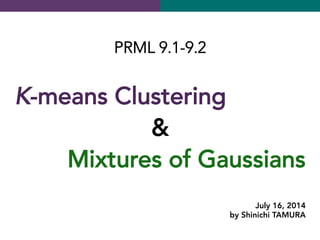The document discusses k-means clustering and Gaussian mixtures, focusing on the clustering problem, its application in image compression, and the EM algorithm for Gaussian mixtures. It explains the iterative method for k-means, involving steps to assign data to the nearest cluster and update cluster means. Variations such as the online version of k-means and strategies like the Robbins-Monro algorithm are also introduced.
















































![Mixtures of Gaussians
K-means Clustering
K-means Clustering
[Variation] 1. On-line version
The case where one datum is observed at once.
July 16, 2014
PRML 9.1-9.2
Shinichi TAMURA](https://image.slidesharecdn.com/20140716prmlslidesrev-150615133653-lva1-app6891/85/PRML-9-1-9-2-K-means-Clustering-Mixtures-of-Gaussians-49-320.jpg)
![Mixtures of Gaussians
K-means Clustering
K-means Clustering
[Variation] 1. On-line version
The case where one datum is observed at once.
> Apply Robbins-Monro algorithm
July 16, 2014
PRML 9.1-9.2
Shinichi TAMURA](https://image.slidesharecdn.com/20140716prmlslidesrev-150615133653-lva1-app6891/85/PRML-9-1-9-2-K-means-Clustering-Mixtures-of-Gaussians-50-320.jpg)
![Mixtures of Gaussians
K-means Clustering
K-means Clustering
[Variation] 1. On-line version
The case where one datum is observed at once.
> Apply Robbins-Monro algorithm
µnew
k = µold
k + ηn(xn − µold
k ).
July 16, 2014
PRML 9.1-9.2
Shinichi TAMURA](https://image.slidesharecdn.com/20140716prmlslidesrev-150615133653-lva1-app6891/85/PRML-9-1-9-2-K-means-Clustering-Mixtures-of-Gaussians-51-320.jpg)
![Mixtures of Gaussians
K-means Clustering
K-means Clustering
[Variation] 1. On-line version
The case where one datum is observed at once.
> Apply Robbins-Monro algorithm
µnew
k = µold
k + ηn(xn − µold
k ).
Learning rate
July 16, 2014
PRML 9.1-9.2
Shinichi TAMURA](https://image.slidesharecdn.com/20140716prmlslidesrev-150615133653-lva1-app6891/85/PRML-9-1-9-2-K-means-Clustering-Mixtures-of-Gaussians-52-320.jpg)
![Mixtures of Gaussians
K-means Clustering
K-means Clustering
[Variation] 1. On-line version
The case where one datum is observed at once.
> Apply Robbins-Monro algorithm
µnew
k = µold
k + ηn(xn − µold
k ).
Learning rate
Decrease with iteration
July 16, 2014
PRML 9.1-9.2
Shinichi TAMURA](https://image.slidesharecdn.com/20140716prmlslidesrev-150615133653-lva1-app6891/85/PRML-9-1-9-2-K-means-Clustering-Mixtures-of-Gaussians-53-320.jpg)

![Mixtures of Gaussians
K-means Clustering
K-means Clustering
[Variation] 2. General dissimilarity
Euclidian distance is not
ü
appropriate to categorical data, etc.
ü
robust to outlier.
July 16, 2014
PRML 9.1-9.2
Shinichi TAMURA](https://image.slidesharecdn.com/20140716prmlslidesrev-150615133653-lva1-app6891/85/PRML-9-1-9-2-K-means-Clustering-Mixtures-of-Gaussians-55-320.jpg)
![Mixtures of Gaussians
K-means Clustering
K-means Clustering
[Variation] 2. General dissimilarity
Euclidian distance is not
ü
appropriate to categorical data, etc.
ü
robust to outlier.
> Use general dissimilarity measure
V(x, x )
July 16, 2014
PRML 9.1-9.2
Shinichi TAMURA](https://image.slidesharecdn.com/20140716prmlslidesrev-150615133653-lva1-app6891/85/PRML-9-1-9-2-K-means-Clustering-Mixtures-of-Gaussians-56-320.jpg)
![Mixtures of Gaussians
K-means Clustering
K-means Clustering
[Variation] 2. General dissimilarity
Euclidian distance is not
ü
appropriate to categorical data, etc.
ü
robust to outlier.
> Use general dissimilarity measure
V(x, x )
E step ... No difference
July 16, 2014
PRML 9.1-9.2
Shinichi TAMURA](https://image.slidesharecdn.com/20140716prmlslidesrev-150615133653-lva1-app6891/85/PRML-9-1-9-2-K-means-Clustering-Mixtures-of-Gaussians-57-320.jpg)
![Mixtures of Gaussians
K-means Clustering
K-means Clustering
[Variation] 2. General dissimilarity
Euclidian distance is not
ü
appropriate to categorical data, etc.
ü
robust to outlier.
> Use general dissimilarity measure
V(x, x )
M step ... Not assured J is easy to minimize
July 16, 2014
PRML 9.1-9.2
Shinichi TAMURA](https://image.slidesharecdn.com/20140716prmlslidesrev-150615133653-lva1-app6891/85/PRML-9-1-9-2-K-means-Clustering-Mixtures-of-Gaussians-58-320.jpg)
![Mixtures of Gaussians
K-means Clustering
K-means Clustering
[Variation] 2. General dissimilarity
To make M-step easy, restrict to the vector
chosen from
>
A solution can be obtained by finite
number of comparison
µk
{xn}
July 16, 2014
PRML 9.1-9.2
Shinichi TAMURA](https://image.slidesharecdn.com/20140716prmlslidesrev-150615133653-lva1-app6891/85/PRML-9-1-9-2-K-means-Clustering-Mixtures-of-Gaussians-59-320.jpg)
![Mixtures of Gaussians
K-means Clustering
K-means Clustering
[Variation] 2. General dissimilarity
To make M-step easy, restrict to the vector
chosen from
>
A solution can be obtained by finite
number of comparison
µk
{xn}
µk = arg min
xn
xn ∈Ck
V(xn, xn )
July 16, 2014
PRML 9.1-9.2
Shinichi TAMURA](https://image.slidesharecdn.com/20140716prmlslidesrev-150615133653-lva1-app6891/85/PRML-9-1-9-2-K-means-Clustering-Mixtures-of-Gaussians-60-320.jpg)











































































